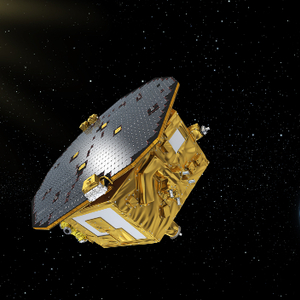
Artist's impression of LISA Pathfinder, ESA's mission to test technology for future gravitational-wave observatories in space. Copyright ESA-C. Carreau
LIGO Congratulates LISA Mission Team
News Release • January 25, 2024
The LIGO Lab congratulates the LISA Mission on its successful ‘Adoption’ by the European Space Agency (ESA) on 25 January 2024. This key step allows the Mission to move to building the spacecraft and planning the launch and operation.
LISA, the Laser Interferometer Space Antenna, is a space-based gravitational-wave detector that focuses on lower frequency signals than the ones accessible to Earth-based detectors like LIGO, Virgo, and KAGRA. This is analogous to the split of optical telescopes (short wavelength) and radio antennas (long wavelength). While LIGO can see binary black hole systems up to hundreds of solar masses, LISA will look at binary black hole systems of millions and billions of solar masses, opening a new window on black hole and galaxy evolution. LISA is led by ESA, in partnership with NASA (the National Aeronautics and Space Administration) and with significant European nation contributions.
LISA is planned for a mid-2030’s launch and a mission extending a minimum of 4 years, extendable to 10 years. Next-generation terrestrial detectors like Cosmic Explorer and Einstein Telescope are planned for operation in the same epoch, and some sources will be seen in all detectors. Importantly, LISA’s orbit and long observation time of stellar-mass black holes will allow it to very accurately pinpoint the source position in the sky and estimate the time of coalescence. Since this will be months to years before the end phase, both terrestrial GW detectors and optical, radio, and particle telescopes can be primed to focus on that direction at the moment of coalescence to try to tease out additional information. By joining terrestrial gravitational wave detectors, LISA will facilitate multi-band gravitational-wave astronomy!
The LIGO Lab wishes the LISA mission a smooth path to launch.
Press Release from LISA Constorium
Press Release from ESA
Press Release from NASA




